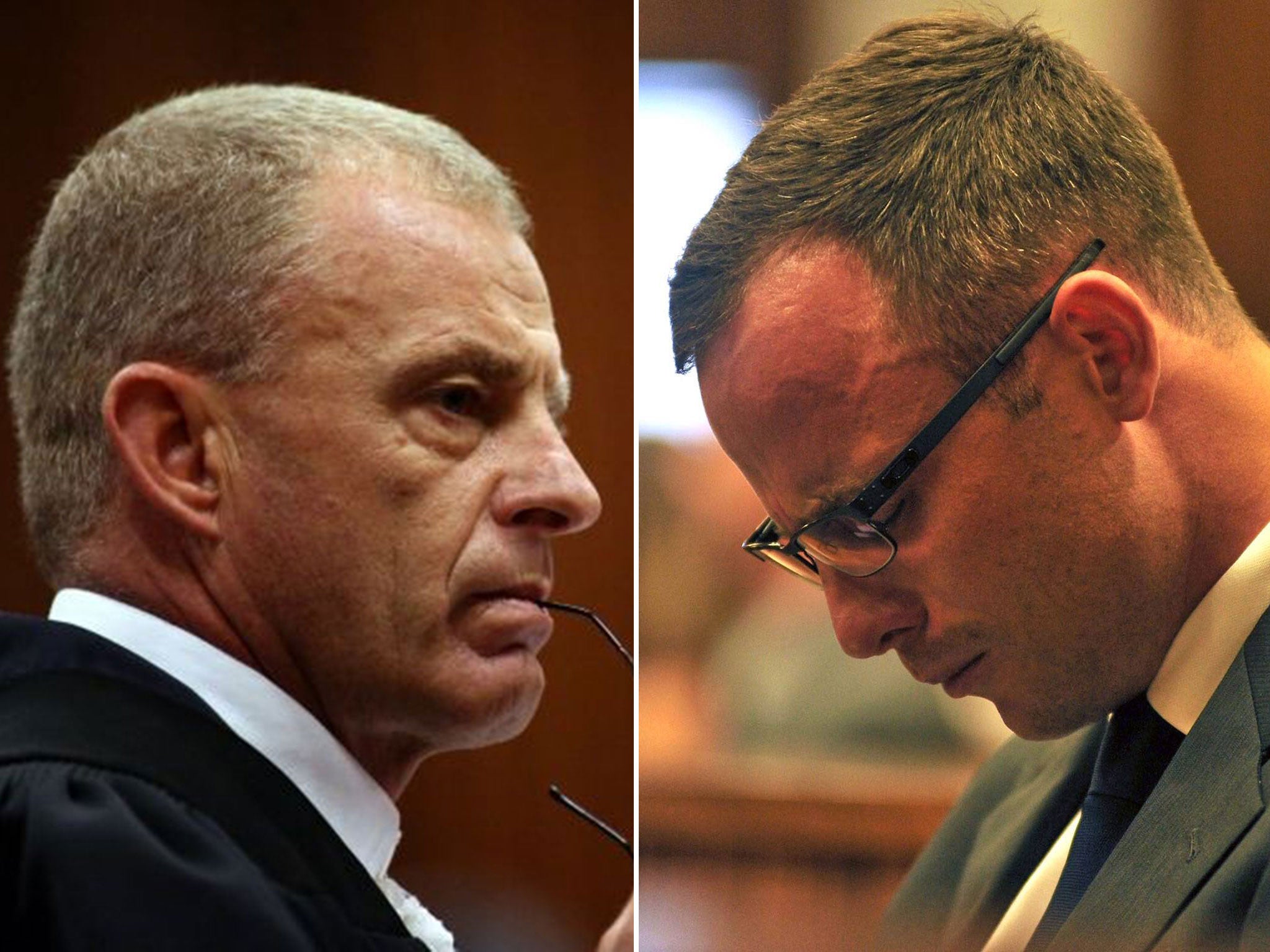Oscar Pistorius trial: Is it a court of law or a bear pit? Enter the adversarial advocate – Gerrie Nel
Gerrie Nel is the latest in a long tradition of ferocious prosecutors


Your support helps us to tell the story
From reproductive rights to climate change to Big Tech, The Independent is on the ground when the story is developing. Whether it's investigating the financials of Elon Musk's pro-Trump PAC or producing our latest documentary, 'The A Word', which shines a light on the American women fighting for reproductive rights, we know how important it is to parse out the facts from the messaging.
At such a critical moment in US history, we need reporters on the ground. Your donation allows us to keep sending journalists to speak to both sides of the story.
The Independent is trusted by Americans across the entire political spectrum. And unlike many other quality news outlets, we choose not to lock Americans out of our reporting and analysis with paywalls. We believe quality journalism should be available to everyone, paid for by those who can afford it.
Your support makes all the difference.We all enjoy a good trial scene in the movies, don’t we? And we appreciate a really fine advocate, skilled at cross-examination – Tom Cruise facing down Jack Nicholson’s fuming Colonel Jessup in A Few Good Men, Spencer Tracy as Clarence Darrow trouncing the anti‑Darwinians in Inherit the Wind, Gregory Peck standing up for the innocent Tom Robinson in To Kill a Mockingbird. Ah, the cut-and-thrust interrogation, the steely logic, the silken put-downs…
Sadly, the everyday reality of courtroom drama is more prosaic, with few climactic revelations and even fewer demands by a gavel-banging judge that the spectators settle down or he will clear the court. So when a new star enters the firmament of public law, we instinctively give him our admiration. Even when it’s in the unpromising environment of North Gauteng High Court, Pretoria, South Africa.
For two weeks, it was just the Oscar Show. The man on trial for the murder of his girlfriend was all we tuned in to see: Oscar weeping, Oscar puking, Oscar displaying ostentatious remorse, Oscar being hugged by his auntie, Oscar ignoring the glares of Reeva Steenkamp’s family, Oscar with his blandly handsome Afrikaaner face and his needy whine of “my lady” (like Parker the chauffeur addressing Lady Penelope in Thunderbirds) at the end of every reply. Then on Day 18, the court dynamic changed.
When Gerrie Nel, the crop-haired, furrow-browed state prosecutor, rose to his feet, nobody could have guessed what was coming.
“Mr Pistorius,” he began cheerily, “you were, and still are, one of the most recognised faces in the world, do you agree?”
A wary silence fell. ”I agree, my lady,” the runner told Judge Thokozile Masipa.
“You are a model for sportsmen, able-bodied and disabled, all over the world?” asked the prosecutor with the same breezy geniality.
“I think I was, my lady,” the defendant replied, “But I’ve made a terrible mistake…”
A frost abruptly descended on the proceedings. “You made a mistake?” asked the prosecutor, incredulously. “You killed a person. That’s what you did, isn’t it?”
Pistorius: “I made a mistake, my lady.”
Nel: “You killed Reeva Steenkamp. That’s what you did.”
Pistorius: “I made a mistake, my lady.”
Nel: “You’re repeating it three times! What was your mistake?”
Pistorius: “The mistake was that I… I took Reeva’s life, my lady.”
Nel: “You killed her! You shot and killed her! Why won’t you take responsibility for that?”
Pistorius: “I did, my lady…”
Nel: “Say it! Say ‘I SHOT and KILLED Reeva Steenkamp’.”
Pistorius: “I did, my lady.”
It was electrifying. In 20 seconds, Nel had turned from prosecution brief to avenging angel. His tone wasn’t questioning. It was furious. He seemed less like a lawyer disputing facts than a moral vigilante.
It was only the start. Nel alternated between pooh-poohing scepticism about Pistorius’s claim that he shot Steenkamp through a door because he’d mistaken her for an intruder, to outright personal contempt. He goaded the runner. He raked him with sarcasm. He rested one foot on a chair as if to get a better purchase. He made Pistorius cry, then asked if his tears were fake. (“You’re getting emotional now because you’re getting frustrated, because your version [of events] is improbable.”) Nel laughed aloud at answers he said were “contradictory”, and was told by the judge to “mind your language” when he called Pistorius a liar to his face.
At one shocking moment, footage was shown of Pistorius gleefully shooting a watermelon at a firing range. “We can see the effect the gun had on the watermelon,” said Nel. “It exploded. That’s the same thing that happened to Reeva’s head. It exploded. Have a look.” A photograph was shown to the shocked courtroom of the dead model’s head with its brains blown out. Pistorius kept his head down.
“I know you don’t want to because you don’t want to take responsibility,” shouted Nel. “LOOK AT IT!”
“I don’t need to look at a picture,” said Pistorius tearfully. “I was there.”
At the end of five gruelling days, it was agreed that Nel, though a frighteningly effective operator, hadn’t landed a killer blow on his victim. But he’d left many people asking: is that how modern cross-examination works? By breaking down the defendant into a quivering, weepy mess? By picking away at microscopic shifts in his story, by hectoring him, shouting at him and calling him a liar? Is it right to treat a defendant as though he’s guilty in a trial that starts with a presumption of his innocence?
In 1903, the American lawyer Francis L Wellman published the bible of advocacy, The Art of Cross-Examination. He laid out the vital characteristics of the effective trial performer: “a habit of logical thought; clearness of perception in general; infinite patience and self-control; power to read men’s minds intuitively, to judge of their characters by their faces, to appreciate their motives… above all, the instinct to discover the weak point in the witness under examination”.
There’s evidently a balance to be struck between finding a witness’s weak points and exercising self-control in not going for him with bared fangs. Wellman stresses the need to have “a pleasant personality”, to come across as a courteous “searcher after the truth”. He is damning about advocates who go too far down the pit-bull route. “The lawyer who is constantly losing his temper and showing his teeth to the witnesses; who wears a sour, anxious expression; who possesses a monotonous, rasping, penetrating voice; who presents a slovenly, unkempt personal appearance; who… seems determined to win at all hazards soon prejudices a jury against himself and the client he represents.”
There is, of course, no jury in the Pistorius trial. South Africa doesn’t have jury trials. Judge Masipa alone will decide the defendant’s fate, helped by two advisers. So Gerrie Nel could allow himself off the leash without fearing he might prejudice any feeble-minded members of the public. But the question of whether it’s better to be a charming pussycat or a relentless Rottweiler has exercised the finest legal minds of the past 2,400 years.
At the trial of Socrates in 399BC, the great philosopher (accusing of corrupting the youth of Athens and “introducing new deities”) ran rings around his chief accuser Meletus by countering his assertions with volleys of counter-questions – the “Socratic method” – until Meletus seemed inarticulate and stupid. Socrates didn’t need to call him names, simply let logic tie him in knots.
In 1778, the great barrister Thomas Erskine took on his first case, defending Captain Thomas Baillie, Lieutenant Governor of the Greenwich Hospital for seamen. He had discovered dubious practices among the hospital management, had complained but been ignored. So he published a whistleblowing pamphlet, and was sued for libel by people working for the First Lord of he Admiralty, Lord Sandwich, whose friends ran the hospital. Erskine cross-examined Sandwich and – even though he was warned by the judge that he was going too far – accused him of being “the dark mover behind the scene of iniquity”. He broke the rules of propriety. But Baillie won the case.
In 1923, the eminent criminal barrister Sir Edward Marshall Hall defended the elegant French wife of the Egyptian prince Fahmy Bey, whom she shot dead at the Savoy Hotel. Hall’s strategy was to lead the prosecution witnesses into making the late prince come across as a sinister, morally dubious foreign johnny who was urging unspeakable sexual deviancy on “a white woman” until he got what he deserved. The princess got off – but the Egyptian ambassador in London complained about this flagrantly unfair and racist piece of playing to the gallery.
At the end of the 20th century, the star advocate in British courts was George Carman, QC, a short, rather peppery, grey-haired, bespectacled defence lawyer who had a way with juries. He successfully defended Jeremy Thorpe the Liberal leader, accused of the attempted murder of a gay model, Norman Scott. He successfully defended The Guardian against a libel action by Jonathan Aitken. Carman’s approach in court was impressionistic: he liked to set several hares racing, to emphasise single words or images to let them settle on the jury’s mind. Neil Hamilton MP, who sued Mohamed al-Fayed for libel and lost because of Carman’s nimble advocacy, compared him to “a malign, forensic squid”, emitting an inky shower of half-truths.
“It’s a work of art, they say in the Temples, George Carman with a witness,” read an Independent profile of Carman in 1992. “The gentle leading-on, inviting ‘yes’ or ‘no’ answers to half-questions, reluctant choices forced and squirrelled away to be assembled into something altogether more damaging in a summing-up. Impressions are created, then worried at until a reputation is chewed into a bloody mess and laid, almost regretfully, before the jury.”
It’s not a place for the faint-hearted, a court of law. And cross-examination is not a forum for an agreeable exchange of opinions about what happened on a certain day. It’s the closest humans come in public life to a bear pit or a bullfight. Whatever rules exist have always existed to be broken if the occasion demands.
Gerrie Nel may have appeared to us a shocking example of the phenomenon. But he was only the latest embodiment of what a search for the truth looks like: noisy, rasping, bloody, fighting to the death.
Join our commenting forum
Join thought-provoking conversations, follow other Independent readers and see their replies
Comments